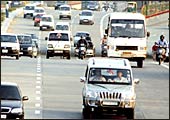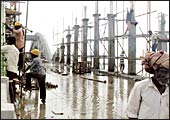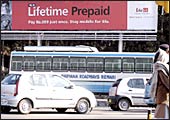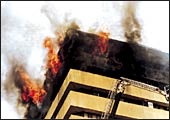SECTOR WATCH
Keep your eyes on these five 'happening' sector' |
 |
 |
|
AUTO
|
CEMENT
|
 |
 |
|
ENGINEERING
|
BANKING |
|
|
|
HOTELS
|
It's
always a good idea to take a few investing tips from the big boys.
If you've been tracking private equity or venture capital companies,
you might have noticed a fundamental shift in their investment
focus. They're all betting big-time on sectors fed by domestic
consumer demand; export-led services are passé. Take VC
firms like Draper Fisher Jurvetson or Oak Partners-both have launched
$200 million (Rs 900-crore) funds to invest in businesses driven
by domestic demand-or funds like ChrysCapital and Citigroup Venture
Capital that have followed suit.
How can long-term investors exploit this
trend to grow their portfolios? While it or pharma continue to
look good as long as India's cost advantage remains, it's now
time they started looking at sectors that depend on domestic demand
and capital spending. This is where the action is going to be
in the next few years. We feature here five such sectors, along
with the most promising stock picks from each.
Auto
Demand in the auto sector has a direct correlation
with economic growth. The per capita GNP grew at a CAGR (compounded
annual growth rate) of 11 per cent between 1971 and 2001 and the
production of passenger cars increased by 9 per cent in the same
period. Now, with the economy on a roll, demand for cars is set
to zoom. Then, with penetration of automobiles in India being
among the lowest in the world, the potential for an upside is
huge. Other catalysts include increased government spending on
infrastructure (think better roads) and soft interest rates. In
October 2005, about 9 lakh vehicles were sold; that's 23 per cent
more than the number sold in October 2004, while the two-wheeler
segment grew 26 per cent. Good picks here include Maruti Udyog
and Mahindra & Mahindra in passenger vehicles, and Bajaj Auto
and Hero Honda Motors in two-wheelers.
Cement
The booming economy translates into a huge
acceleration in retail housing and infrastructure projects. The
obvious gainer is cement, where the demand-supply scenario looks
good. No new capacity is being added, and cement prices had gone
up 10.8 per cent year-on-year till November 2005. A recent report
from broking firm Sharekhan says: "We believe the demand-supply
equation will be favourable for cement companies for the next
two to three years. We retain our bullish stance." Producing
144 million tonnes per annum, the Indian cement sector is the
world's second largest after China. However, per capita consumption
is only 110 kg against a world average of 260 kg, indicating the
potential for growth. Top picks include UltraTech Cement, Madras
Cements, Associated Cement Co. and Grasim.
Engineering And Capital Goods
As long as infrastructure and power remain
a priority of the government, the engineering and capital goods
sectors hold promise. Power is the largest contributor to engineering
companies' revenues. ABB and BHEL, for instance, derive almost
two-third of their revenues from equipment supply to power companies.
With the government aiming to invest Rs 4,00,000 crore each in
generation, transmission and distribution, the opportunities are
obvious. Infrastructure is the other big growth area, with industries,
housing, expressways, and bridges generating enough work for companies
like L&T and IVRCL. The government has recently set up a Rs
10,000-crore special purpose vehicle to exclusively finance infrastructure
development. Picks: BHEL, Siemens, Crompton Greaves, L&T and
IVRCL.
Banking
This is another sector whose fortunes are
directly linked to economic growth. Banking is at its peak, with
PSU banks aggressively competing with MNC banks. Retail lending
(mainly mortgage financing) accounts for a significant 40 per
cent share of loan portfolios. With increased penetration into
semi-urban and rural areas, banks could garner more low-cost deposits.
On the policy side, the sector is headed in the right direction.
For private sector banks, the government has already lifted the
cap on voting rights of 10 per cent as well as opened up 74 per
cent to foreign ownership (FDI, FII and NRI). Given the low credit
penetration and strong capex cycle, credit growth can only increase.
Scrips to watch: ICICI Bank and State Bank of India.
Hotels
If you were a traveller scouting for hotel
rooms in India's Class A cities, you would have first-hand experience
of the potential in hospitality. There are virtually no rooms
available. Ergo, occupancy rates have shot up. Private equity
firms have realised the potential-WestBridge Capital invested
$5.7 million (Rs 25.65 crore) in Royal Orchid Hotels, while Bessemer
Venture Partners and New Vernon put in $8.5 million (Rs 38.25
crore) into Sarovar Growth-and will be driven by strong demand.
The potential for growth is also significant. Indian Hotels, for
instance, has entered the low-cost hotels business with its indiOne
brand. Other picks: East India Hotels (EIH), Hotel LeelaVenture
and Taj GVK Hotels and Resorts.
Aim And
Shoot
As financial institutions succumb to the urge
to converge, customers are not complaining. They are getting better
choice and lower prices.
By Anand Adhikari
 When
35-year-old Pawan Parmar approached banks and mutual funds to
manage his investments under their wealth management services,
almost all of them turned him down. The reason: Parmar's Rs 6
lakh was too low to qualify for their services; their minimum
investment ceiling was Rs 25 lakh to Rs 2 crore. When
35-year-old Pawan Parmar approached banks and mutual funds to
manage his investments under their wealth management services,
almost all of them turned him down. The reason: Parmar's Rs 6
lakh was too low to qualify for their services; their minimum
investment ceiling was Rs 25 lakh to Rs 2 crore.
Then Parmar discovered portfolio management
services or PMS-it's akin to wealth management but is offered
by stock broking outfits for minimum investments of only Rs 5
lakh. It was just the solution Parmar needed. And just the kind
of solution now increasingly available across the financial services
industry.
The reason is convergence-a sort of backward
integration that's rapidly taking place among financial services
companies, with all players offering unified personal finance
solutions. The phenomenon has played quite a big role in improving
both the choice available to the customer and the price.
Look, for instance, at what happened in the
housing finance industry. For decades, consumers banked on housing
finance companies (HFCs) for home loans. But when some market
savvy banks, with access to cheap funds, stormed the home loan
market towards the end of the 90s, the industry's growth shot
through the roof. Innovations like money market fixed rate/floating
rate loans became popular, so much so that even the traditional
HFCs, including the 25-year-old housing finance pioneer HDFC,
were forced to follow suit. Net result? Competition pushed down
home loan rates and consumers flocked towards housing finance.
Today, banks hold 60 per cent of the home loan market.
As the personal finance market grows, almost
all financial services companies are moving into newer pastures
by invading territory that was traditionally considered someone
else's fiefdom. Just as banks intruded on HFC turf, financial
services providers of all hues-stockbrokers, mutual funds, insurance
firms-are marching into each other's territory. Mutual funds (MFs)
are offering insurance as a sweetener; life insurance firms are
not just enticing consumers with credit, but also with health
and accident insurance cover, which were traditionally the preserve
of general insurance companies. And PMS has moved out of banks
to MFs and stockbrokers while MFs also eye the lucrative pensions
sector, which is due for a dose of liberalisation. "Such
blurring will happen right across the financial services industry.
In fact, it should be expected," says Naval Bir Kumar, Managing
Director, Standard Chartered Asset Management Company.
Here's a quick look at the various kinds
of combo offers now available and what it means for you.
One big move has been the entry of the Rs
2,00,000-crore mf industry into the life insurance territory.
Reliance Mutual Fund set the ball rolling with its Reliance Tax
Saver (ELSS) Fund, which also offered cover for death by rail
or road accident up to a maximum of Rs 5 lakh. A minimum investment
of Rs 10,000 in Reliance Tax Saver offered an insurance blanket
of Rs 50,000. In fact, DSP Merrill mf came out with the most comprehensive
insurance cover with a systematic investment plan (SIP) to choose
from several mf schemes. And if you go by what mf head honchos
have to say, a string of money managers is preparing to launch
the mf-insurance combo special. "The world has changed; you
have to look at co-operation and competition. We will certainly
look at a scheme with an insurance add-on," says Ved Prakash
Chaturvedi, CEO, Tata MF. "MFs, with their large size and
diversified portfolio, offer a much better vehicle for savings
during the accumulation stage than an insurance company,"
says Kumar. An mf industry official points out that over a five-year
period, products of insurance companies are far more expensive
as the percentage of the first premium that goes to the distributor
is a steep 30-40 per cent.
Life insurance players, however, counter
by saying they offer high-value life insurance.
"We also protect the early risk of death
and disability," says Ian J. Watts, MD, Tata AIG Life Insurance
Company. Global statistics reveal that before the retirement age
of 65, a person is five times more likely to have a critical illness
like a stroke or a loss of limb.
"That means you are more likely to outlive
your retirement. That's where insurance companies offer benefits
to pay sums of money in the event of those situations happening,"
defends Watts. He has a point, but then again, what's stopping
a mf from offering critical illness cover in future, you have
to wonder.
In yet another convergence play, Reliance
mf has been offering an ATM-cum-international debit card to its
investors for easy liquidity anywhere, anytime. As a customer
why would you complain?
If you think MFs are unfairly treading on
life insurance or banking services' turf, the life players are,
meantime, being blamed by the general insurance players for stepping
on their toes. As Kamesh Goyal, CEO, Bajaj Allianz General Insurance
Company, points out: "There is a convergence play in the
health, credit insurance and personal accident segments, where
life insurance players are getting in." Typically, general
insurance is a pure protection against contingencies without the
promise of returns. Example: the mediclaim policies offered for
decades by the state-owned general insurance companies. But this
distinction is now getting blurred. Tata AIG Life Insurance Company
offers a comprehensive health policy that encompasses a daily
hospitalisation allowance, surgical benefits, post-hospitalisation
expenses, critical illness cover plus a term life cover. "We
are probably the most focussed on health amongst the life players,"
boasts Bimal Balasingham, Director, Tata AIG Life Insurance Company.
Credit insurance is also being keenly eyed by the life insurance
pack. SBI Life, having already entered into a tie-up with credit
insurance major Cardiff, has big plans.
The lines are also getting blurred when it
comes to services like portfolio management, typically targeted
at high net worth individuals. Chasing this loaded bunch are not
just stockbrokers, but mutual funds, who prefer to call it wealth
management; and banks, which term it private banking. Banks like
Societe Generale claim they're better placed to service the customer,
thanks to the clutch of sophisticated offerings like derivatives
and structured products in their armoury. "Many players in
the Indian market (stock brokers and MFs) lack such products,"
says Pierre Baer, Executive Director (Asia Pacific), Societe Generale,
which has launched its wealth management services in India with
a minimum investment of Rs 2.5 crore.
Brokers, of course, have a slightly different
view. "Performance is the differentiating factor in today's
market. We have clocked a return of 150 per cent in the last one
year and 325 per cent since inception in 2003 in PMS," says
Mihir Kothari, Head (Equity Advisory Group), Motilal Oswal Securities.
In 2005, a number of players, including ABN AMRO, BNP Paribas,
UTI Bank, HSBC Asset Management Company and ICICI Securities,
bagged licences from SEBI to offer PMS. "The pie is big enough
for everybody to share," avers Chaturvedi of Tata Mutual
Fund.
And the best news for customers is the entry
of small-sized players into the arena. What were once neighbourhood
agents, who bought your insurance covers or mf schemes, have morphed
into full-fledged outfits that manage portfolios as small as Rs
1-2 lakh. They not only advise you on the mf-insurance-tax-savers
combos that you need, but also make and track your premium payments
or redemptions. And charges are not exorbitant.
Then, of course, there are the PSU banks
selling post office schemes while post offices and banks sell
mf units while almost everybody offers to let you pay your bills
through them. The resulting competition keeps them all on their
toes and prices under check. All in all, quite a satisfactory
state of affairs.
MIX AND MATCH
Convergence among mutual funds, broking houses,
banks, life and non-life insurance players has brought in wider
choice at different price points for investors like Pawan Parmar.
However, it's good to get your facts straight.
For instance, when your life insurance comes bundled with investment,
as in a five-year ULIP (unit-linked insurance plan) from a life
insurance company, is this convergence play instantly a good idea?
Experts say no. It makes more sense to instead buy a mutual fund
that offers insurance cover. "MFs are purely an investment
vehicle. They enjoy scale and they also translate that scale at
much lower cost to investors," says Naval Bir Kumar of Standard
Chartered Bank.
If, however, you are looking for pure death
cover or critical illness riders, then why buy a mutual fund?
At that point, it's life insurance companies that will have the
best deals.
Or take the health segment, where both life
and non-life insurers are offering a mix-and-match of all kinds
of covers. Here, experts say the advantage lies in buying a health
cover from a life insurance company, as you then get an additional
death benefit. For instance, Tata AIG Life's Health Protector
scheme comes with an additional benefit of Rs 50 lakh (maximum)
in the event of the policyholder's death. For pure health policies,
general insurance companies are the best bet as they reimburse
you on actuals, but if you want the additional death benefit,
a life cover is better.
Convergence per se is not the answer-first
find out what you need from the product.
NEWS ROUND-UP
'Allo! 'Allo!
 |
| Airtel's lifetime offer: Is it really
all that worthwhile? |
The whole market's abuzz
with lifetime free offers. The attempt, of course, is to capture
a customer for life. And, as Naresh Malhan, President (Operations-North),
Tata Teleservices, says: "It's human nature that as you get
more used to the mobile, usage will start picking up."
However, there's more to lifetime offers
than meets the eye. First, call charges at Rs 1.99 per minute
for local and Rs 2.99 per minute for STD are not necessarily low.
Customers with ordinary prepaid cards pay anything from Rs 0.70
(local) to Rs 1.20 (STD). As BSNL Finance Director S.D. Saxena
puts it, these schemes do not benefit customers who make outgoing
calls. They are for those who don't (but receive lots of calls),
such as an aged parent or a chauffeur who have traditionally opted
for 'free-incoming' schemes. Then, the talk time offered by lifetime
schemes (between 12 minutes in the case of private telcos and
49 minutes for BSNL) is too low for the Rs 999 they charge. Most
telcos claim that customers will not have to pay any transaction
charge on future recharges and that they will get the entire talk
time they pay for.
Next is the whole question of 'lifetime'.
As far as we can make out, all the telcos stipulate that the cards
must be recharged at least once in six months for you to stay
connected. And, at least one telco has stipulated that the scheme
remains valid only as long as the subscriber has a minimum charge
of Rs 5 in the account. If the amount falls below that, the subscriber
pays the entire Rs 999 again. Finally, there's no clarity on what
happens if a customer moves cities.
Given that TRAI is looking into the whole
concept to see how free "lifetime free" really is, and
its report is expected in February 2006, consumers would do well
to wait and watch. Also, given that STD rates, indeed all mobile
rates, are set to fall drastically, why tie yourself permanently
to one telco right now?
-Kumarkaushalam
 |
| ING Vysya: And now, Self Banks too |
Banking On Service
The ATM reduced the number of bank visits
and the time wasted in queues and filling forms; now ING Vysya
Bank takes the idea of anytime banking to the next level. After
a successful launch in Belgium and Romania, Dutch financial services
giant ING Group introduces the Self Bank concept here. The idea
is to provide customers a full bouquet of banking services 24
hours a day through self-service kiosks, where you can get full
account statements, net banking, and access the bank's call centre.
"Customers today want more flexibility to operate their accounts
and the Self Bank helps us address this demand," says Shantanu
Ghosh, Country Head (Retail Banking), ING Vysya. The outlets will
have an ATM, a self-service outlet and a sales area, where ING
Vysya Financial Services executives will be at hand during working
hours to sell bank products. The bank has tied up with Euronet
Worldwide, an electronics payment provider, to launch 200 such
outlets across the country over the next two years.
-Rahul Sachitanand
Exemptions Continue
Ever since P. Chidambaram's
last budget announcement, tax payers have lived in dread of the
Exempt-Exempt-Taxed (EET) regime. Weeks short of this budget,
there's good news: If the buzz in the finance ministry is to be
believed, EET will probably not be announced this year.
In the long run, though, be prepared to face
the tax axe at the stage of withdrawal at least, even if spared
during the investment and accumulation stages. Says Nikhil Bhatia,
Partner, BSR & Co., Delhi-based tax consultants: "Small
savings instruments such as PPF (Public Provident Fund), where
funds are locked in for 15 years at 8 per cent, will no longer
be attractive, as the rate of return may fall to 5.3 per cent
after tax (presuming tax at the maximum marginal rate on withdrawal)."
Insurance, too, will become costlier as maturity proceeds will
be taxed.
-Kumarkaushalam
In The
Limelight
Why is everyone launching close-ended funds?
UP CLOSE
Why a close-ended fund could give better
returns |
|
»
Can create long-term portfolio
» Can
buy growth stocks: mid- and small-caps
» Can
diversify into debt
» Can
lower distribution costs as churning's absent
|
Before 2003,
mutual funds were heavily biased towards debt. Then came the bull
run and the market was awash with open-ended equity schemes. Now,
close-ended schemes are suddenly all the rage.
Franklin Templeton, HDFC Mutual Fund, ING
Vysya, Tata-they are all in the fray. Why this sudden interest
when open-ended funds are clearly outperforming indices?
Unlike open-ended funds that provide seamless
liquidity, close-ended funds are locked in for a pre-defined period
of six to 15 years. Fund managers thus have ample scope to take
long positions in growth-oriented stocks, including mid- or even
promising small-caps. "We could see close-ended funds taking
exposures in debt too, as the future of debt looks promising,"
says the CEO of a state-owned mutual fund.
Earlier, close-ended funds were listed in
the market and traded at a discount to their NAVs (net asset values),
which resulted in their ultimately converting to open-ended. "Close-ended
funds now offer limited exit options by way of a higher exit load
(4 per cent) or allowing exits every six months, which is good
for the market," says Dhirendra Kumar of Value Research.
Will returns be higher in close-ended funds?
Yes, but only if the market stays bullish. "Theoretically,
a close-ended fund offers better scope for returns, but it all
depends on the market," says N. Mohan Raj, CEO, LIC Mutual
Fund.
Three consecutive bull years have whetted
people's appetites for higher returns, possibly pushing mutual
funds to bet on close-ended schemes. Sceptics, however, dismiss
the comeback as yet another lure to mobilise cheap funds. "Small
investors are lapping up whatever they get; I don't see any big
trend in close-ended funds," says Kumar.
Invest, but only if you're comfortable with
the illiquidity.
-Anand Adhikari
SMARTBYTES
Credit From Everyone
 |
| Peerless scores a first: Comes up with
a credit card |
A first in the personal finance space: a credit
card from a non-banking financial company (NBFC). Kolkata-based
Peerless General Finance and Investment Company, the country's
largest residuary non-banking company (RNBC), has launched the
Peerless-ICICI Bank Affinity Card. The launch comes on the heels
of RBI's announcement encouraging NBFCs to get into the credit
card business. For ICICI Bank, it's a chance to leverage Peerless'
legendary network of field staff (more than 150,000) while for
Peerless, it is one more step towards becoming a financial products
supermarket. Incidentally, Peerless has a depositor base of over
40 million. The lifetime free card-there is no joining or renewal
fee-comes with most standard features, and is one more proof that
easy credit is here to stay.
-Ritwik Mukherjee
Loans After 60
If age isn't on your side, chances of getting a
loan or credit card are remote. In fact, it's tough all around
for retirees, what with rock-bottom interest rates, growing medical
costs and spiralling inflation. The good news: some PSU banks
are ready to lend a hand with personal loans at concessional rates
of 11.5 per cent to 12.5 per cent. LIC Housing Finance offers
a concessional home loan at 7.7 per cent, the only condition being
that the entire loan or 30 per cent or more is repaid out of retirement
benefits. Bank of Baroda's personal loan for pensioners, with
a generous upper limit of Rs 1.5 lakh, comes at 11.5 per cent
against the regular 12 per cent. For defence personnel, the rate
is 10.5 per cent, says a BoB official. There's a bonus to ageing
after all.
-Anand Adhikari
Left On The Fringe
As Budget Day comes closer, individuals and
companies are united in one demand: Would the Finance Minister
please scrap the FBT?
By Ritwik Mukherjee
 |
| Salaried individuals: Bearing the brunt
of FBT |
Facts
first. Personal income tax collection after the fringe benefit
tax (FBT) stands at Rs 66,000 crore, up 20 per cent from last
year's Rs 50,000 crore. Little wonder that Finance Minister P.
Chidambaram in a televised interview on January 19 ruled out the
withdrawal of the controversial tax. For companies, the only consolation
has been the fm's assurance that "some simplifications"
would be brought into the FBT provisions. But what about the salaried
individual?
Interestingly, sources in Income Tax circles
say the phenomenal rise in personal income tax collection is not
so much due to FBT collections but because most companies have
changed the structure of their pay packets so that a higher share
of the salaries being paid is taxable income. So, who's the loser?
No prizes for the right answer.
Did the Finance Minister really think it
would pan out any other way? Business considerations require that
certain expenses have to be made by companies-in economic parlance,
these are called inelastic expenses. "There are certain benefits,
which if the employer doesn't offer, any competent employee would
look for a job somewhere else, but if you tax these, it is inevitable
that many companies would simply restructure pay packets,"
says Rathin Datta, Chairman, PricewaterhouseCoopers India, and
among the best known tax experts in the country. Therefore, while
salaried individuals are not losing out on any of the fringe benefits
they enjoyed before FBT, they are certainly paying more personal
income tax on them.
Siddhartha Sankar Sen, another leading tax
consultant, says he is not aware of any company that has actually
withdrawn these perquisites from its employees. However, since
companies have to pay taxes on the perks they give to employees,
they are simply making the perks part of the employee's whole
pay package or CTC (cost-to-company). What the employee once enjoyed
as a tax-free perk is now part of her taxable income, thus neatly
passing on the burden of tax to the employee. The finance minister's
move has simply added on an extra burden to the same salaried
class that already pays its taxes faithfully.
Meanwhile, companies too are chafing at the
FBT, which taxes genuine business expenses as well as perks. Corporate
India is complaining that it is unfair on companies whose business
includes a large component spent on travel, entertainment and
business promotion expenses. Comments Datta: "When you tax
a benefit, the benefit has to be direct, tangible and quantifiable;
it cannot be nebulous. I have great doubts if genuine business
expenses offer any direct benefits. Besides, the compliance cost
of FBT collection is high, as a result of which the cost of business
increases significantly and profitability falls. It also goes
against the principle of simplification."
Ideally, as other tax experts point out,
the net impact of FBT could actually be lowered for both companies
and employees if salaries are structured judiciously. Rather than
pass the entire burden on to the employee, companies could continue
the perks and reimbursements, pay the FBT on them, but thereafter
structure CTCs in such a way that the FBT is factored in. This
would lower the employee's tax burden considerably while not hurting
the employer.
How many companies are actually going to
sit down and plan CTCs only with reference to income tax and FBT
payments? It's more likely they will simply pass the burden on
to employees and sit back.
The best solution, of course, would be the
fm scrapping this whimsical tax altogether.
LIFE AFTER DETARIFFING
By this time next year, be prepared to have
your insurance premiums determined by your lifestyle choices.
By Nitya Varadarajan
 |
 |
| Fire and motor insurance: The two categories
are expected to be the most affected when the detariffing
regime falls into place |
If you are a
law-abiding driver, remember the frustration when a maniac overtakes
you from the left? And then causes a pile up five cars deep. It
seems logical that such drivers should pay more for their motor
insurance than you do, but it doesn't happen that way. Not yet,
at any rate.
If, however, insurance detariffing comes
into being, this is one of the things that could happen under
the new regime.
Detariffing has been on the cards for a while
now and the present deadline is January 2007. There is still a
lack of consensus on the whats and hows of the new dispensation,
but experts largely agree that the makeover is imminent. Says
K.N. Bhandari, former Chairman of New India Assurance, and now
the Director of the Centre for Insurance Studies and Research:
"IRDA (Insurance Regulatory and Development Authority) is
trying to condition the market and the stakeholders." Companies
have to first build an extensive database to quote the right tariffs
post detariffing. IRDA has said that companies will have to justify
premiums and present them to the regulator for approval.
| DETARIFFING WILL BRING IN: |
|
»
Customised cover. Thus, a "safe" driver
could pay lower premiums than a "rash" one
»
Higher premiums. As insurers face higher distribution costs
and stiffer competition, they could make it up by raising
premiums
»
Specialised covers. Without administered prices, companies
will be more ready to insure hitherto uncovered areas like
adventure sports
»
Some low premiums. Fire insurance premiums are likely to
drop sharply
|
While this does offer some protection to individual
policyholders, on the whole, detariffing will be a mixed blessing-while
you can now cock a snook at the road hog, it will also result
in a general increase in premium rates across the board.
First, the basics. Premiums for general insurance
policies today are fixed by two bodies-the Tariff Advisory Committee
(TAC) and individual insurance companies. TAC fixes the premium
rates for motor, fire, marine (hull), workmen compensation and
engineering business portfolios. These are called tariff businesses
and constitute nearly 70 per cent of the Rs 18,000-crore market.
Detariffing will allow insurers to fix premiums themselves based
on their assessment of risks.
For the insurers, the move will hopefully
end cross-subsidisation between businesses. At present, the fire
insurance business is the most profitable (with a claims ratio
of around 40 per cent), and ends up subsidising loss-making areas
like motor and health insurance.
Individual policyholders are in for a sea
change. Be prepared, for instance, to see your motor insurance
premiums change based on your age, sex, the car model or even
colour. So, a young male-perceived to be a faster and therefore
less safe driver-will pay a higher motor premium than a middle-aged
woman.
An average person usually buys fire, household,
health (including accident), travel, and motor covers. Already,
individual premiums are far higher than corporate premiums for
the same cover. For instance, burglary cover under a householder's
policy is Rs 2.40 per Rs 1,000 of sum insured vis-à-vis
about 0.01 paise for companies. Now, costs could get higher. Says
Bhandari: "Premium rates in India are among the lowest in
the world and the one way it can go is upwards."
Why will premium costs increase? With detariffing,
insurers will face increased distribution costs. At present, the
tariff business pays 12.5 per cent of premium to brokers and 10
per cent for agents; while the non-tariff business pays 17.5 per
cent and 15 per cent, respectively. Second, competition could
reduce premiums on some business lines, like fire insurance, to
uneconomical levels. Also, although insurers want to increase
motor insurance rates, a strong transport lobby may not allow
it.
Industry sources say insurers are unable
to manage personal covers profitably, leaving them with little
choice but to increase premiums. Already, insurers are talking
of increasing mediclaim premiums. However, Arun Agarwal, Managing
Director, Cholamandalam ms General Insurance Company, says: "Prudence
and good practice will ensure better risk rating and thus lower
premiums."
Of course, once pricing is deregularised,
customers are likely to get far more customised and novel covers,
much of which is not available today. Bottomline: Next year could
see a sea change in how you buy insurance.
IGNORED AS USUAL
 One
of the roles of the Insurance Regulatory and Development Authority
(IRDA) is to protect the interest of individual policyholders.
And one good way to do this would be to hear their views on important
issues. The regulator, however, seems to have failed them in this
aspect. Some months ago, IRDA set up the K. P. Narasimhan Committee
to suggest amendments to the Insurance Act 1938. One
of the roles of the Insurance Regulatory and Development Authority
(IRDA) is to protect the interest of individual policyholders.
And one good way to do this would be to hear their views on important
issues. The regulator, however, seems to have failed them in this
aspect. Some months ago, IRDA set up the K. P. Narasimhan Committee
to suggest amendments to the Insurance Act 1938.
Unlike the Telecom Regulatory Authority of
India (TRAI), which goes to various cities to gather the views
of different sections of people to its proposals, IRDA called
for submissions and comments from individuals to the Narasimhan
Committee to be made on its website (www.irdaindia.org). Unfortunately,
the site is difficult to navigate and short on information for
the lay policyholder. Given the low penetration of computers and
net connections, as also of the concept of insurance itself, it
is difficult to see how IRDA thought this move would be enough
to percolate to the masses.
The Narasimhan Committee has had submissions
so far from insurers, surveyors and from the American Insurance
Association. Curiously, the one body that has given suggestions
on a grievance redressal mechanism for individual policyholders
is the IRDA itself.
Incidentally, for a couple of years now,
IRDA has been saying that it's in the process of revamping its
website. Nothing seems to have happened yet.
Value-picker's Corner
SHASUN CHEMICALS & DRUGS; PRICE:
RS 100.55
As global pharma starts outsourcing non-core activities,
companies like Shasun Chemicals & Drugs will benefit hugely. A
recent shift in focus to custom chemical synthesis, plus a new
formulations unit for the generics market is expected to benefit
Shasun. It has also recently bought the French Rhodia group's
pharma custom synthesis business, which expands its client base
in the US, Europe and Asia. For the quarter ended December 2005,
Shasun reported a 43 per cent rise in net profit to Rs 12.9 crore.
At Rs 100.55, the stock trades at a P-E of 9.4 on an annualised
EPS of Rs 10.73. A reasonable valuation, given companies in its
peer group are trading at P-Es of 20-40.
-Mahesh Nayak
 |
| Loan rates: Will they soon take the
high road? |
Trend-spotting
Bad news for borrowers: the hikes in repo and reverse
repo rates by the RBI (Reserve Bank of India) may push up lending
rates. Already, HDFC (Housing Development Finance Corporation
Ltd) has raised its home loan rate by 50 basis points. RBI Governor
Dr Y.V. Reddy's move aims to absorb excess liquidity and make
funds costlier for banks, but will likely hit retail borrowers
hard. Although K. Cherian Varghese, Chairman, Union Bank of India,
says: "Competition and liquidity will decide the future of interest
rate movements," the effect on liquidity is already being felt.
All eyes are now on the Budget, as income tax exemptions on savings
deposits are expected, thus increasing banks' low-cost deposit
base. Also, there are hints the hike could be reversed.
-Anand Adhikari
|









 W
W





 One
of the roles of the Insurance Regulatory and Development Authority
(IRDA) is to protect the interest of individual policyholders.
And one good way to do this would be to hear their views on important
issues. The regulator, however, seems to have failed them in this
aspect. Some months ago, IRDA set up the K. P. Narasimhan Committee
to suggest amendments to the Insurance Act 1938.
One
of the roles of the Insurance Regulatory and Development Authority
(IRDA) is to protect the interest of individual policyholders.
And one good way to do this would be to hear their views on important
issues. The regulator, however, seems to have failed them in this
aspect. Some months ago, IRDA set up the K. P. Narasimhan Committee
to suggest amendments to the Insurance Act 1938. 